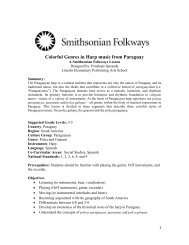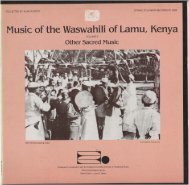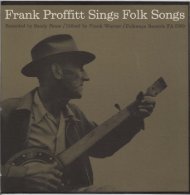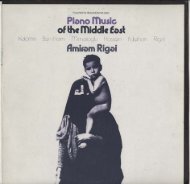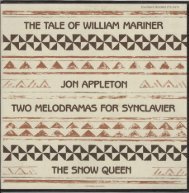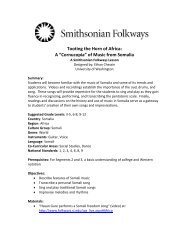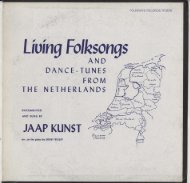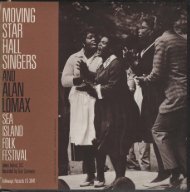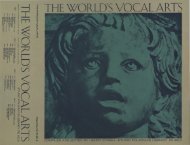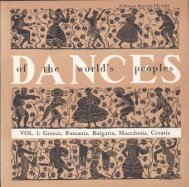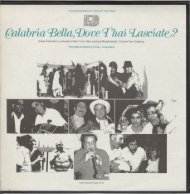Beats, Rhythms, and Drums: Grooves of the World
Beats, Rhythms, and Drums: Grooves of the World
Beats, Rhythms, and Drums: Grooves of the World
You also want an ePaper? Increase the reach of your titles
YUMPU automatically turns print PDFs into web optimized ePapers that Google loves.
vibrations made when sound occurs (for example, hold a ruler on <strong>the</strong> edge <strong>of</strong> a<br />
desk, with most <strong>of</strong> <strong>the</strong> ruler sticking over <strong>the</strong> desk. Hit <strong>the</strong> ruler <strong>and</strong> listen to<br />
<strong>the</strong> sound while watching <strong>the</strong> vibration; Or strum a rubber b<strong>and</strong> stretched<br />
across fingers <strong>and</strong> listen to, see <strong>and</strong> feel <strong>the</strong> vibrations.) Help students<br />
underst<strong>and</strong> that drums depend on <strong>the</strong> activation <strong>of</strong><br />
vibrations—mostly by human h<strong>and</strong>s or mallets <strong>and</strong> sticks held by human<br />
h<strong>and</strong>s.<br />
Assessment: Students will be able to explain <strong>and</strong> demonstrate <strong>the</strong> principle <strong>of</strong> sound<br />
vibration on an instrument or found-sound.<br />
Second Lesson: There’s A Pattern In That Rhythm (National St<strong>and</strong>ards #2, 3, 6, 8, 9)<br />
a) Have students listen to <strong>the</strong>ir own personal rhythm: <strong>the</strong>ir heart beat. Have<br />
<strong>the</strong>m find <strong>the</strong>ir heart beat or <strong>the</strong>ir pulse, <strong>and</strong> tap out <strong>the</strong> rhythm <strong>the</strong>y hear: an<br />
endless pattern <strong>of</strong> steady beats.<br />
b) Review <strong>the</strong> meaning <strong>of</strong> “patterns” as established in math <strong>and</strong> <strong>the</strong> visual arts.<br />
c) Focus on how a steady beat is a pattern, <strong>and</strong> how o<strong>the</strong>r rhythms are also<br />
patterns <strong>of</strong> sound.<br />
d) Have students create visual patterns <strong>and</strong> assign a sound to each “picture” that<br />
<strong>the</strong>y can perform with body percussion.<br />
For example: =clap =stomp<br />
The pattern could be performed in this manner:<br />
clap-clap-clap-stomp clap-clap-clap-stomp<br />
Perform various created rhythm patterns.<br />
After clapping, snapping, <strong>and</strong> stomping <strong>the</strong> rhythms created from <strong>the</strong>se<br />
visual patterns, ask students to transition to drums.<br />
The pattern could now be performed in this manner:<br />
HHHL HHHL<br />
BBBD BBBD<br />
[H= higher L=lower, B=brighter D=duller]<br />
e) Without visual pictures, challenge students (working independently with<br />
partners <strong>and</strong>/or in small groups) to create musical patterns using <strong>the</strong>ir pencils<br />
(or palms/fingers). Have <strong>the</strong>m play around with different patterns <strong>and</strong> use<br />
different surface areas to “drum” <strong>the</strong>se patterns. What do <strong>the</strong>y notice? What<br />
kinds <strong>of</strong> surfaces make higher pitches – drums, drums sticks, palms with open<br />
fingers or closed fingers? Which make lower pitches?<br />
f) Introduce Ella Jenkins Folkways site <strong>and</strong> have students listen attentively to <strong>the</strong><br />
track with drum rhythms (#113).<br />
http://www.folkways.si.edu/albumdetails.aspx?itemid=2106<br />
3




